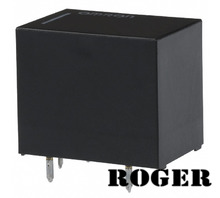
G5LE-14 DC12
- Artikelnummer:
- G5LE-14 DC12
- Hersteller:
- Omron
- Beschreibung:
- RELAY GEN PURPOSE SPDT 10A 12V
- RoHS-Status:
- Bleifrei / RoHS-konform
- Menge auf Lager:
- 76428 Pieces
- Lieferzeit:
- 1-2 days (We have stocks to ship now)
- Produktionszeit:
- 4-8 weeks
- Datenblatt:
- G5LE-14 DC12.pdf
Einführung
We can supply G5LE-14 DC12, use the request quote form to request G5LE-14 DC12 pirce and lead time.XXX.com a professional electronic components distributor. With 3+ Million line items of available electronic components can ship in short lead-time, over 250 thousand part numbers of electronic components in stock for immediately delivery, which may include part number G5LE-14 DC12.The price and lead time for G5LE-14 DC12 depending on the quantity required, availability and warehouse location.Contact us today and our sales representative will provide you price and delivery on Part# G5LE-14 DC12.We look forward to working with you to establish long-term relations of cooperation
Spezifikation
| Interne Teilenummer | RO-G5LE-14 DC12 |
|---|---|
| Bedingung | Original New |
| Herkunftsland | Contact us |
| Top-Markierung | email us |
| Ersatz | See datasheet |
| Turn On Spannung (max): | 9 VDC |
| Turn Off Spannung (min): | 1.2 VDC |
| Abschlussart: | PC Pin |
| Schaltspannung: | 250VAC, 125VDC - Max |
| Serie: | G5LE |
| Veröffentlichkeitsdatum: | 5ms |
| Relaistyp: | General Purpose |
| Verpackung: | Tray |
| Andere Namen: | G5LE-14-DC12 G5LE1412DC G5LE14DC12 G5LN8006R Z1012 |
| Betriebstemperatur: | -40°C ~ 85°C |
| Anzugszeit: | 10ms |
| Befestigungsart: | Through Hole |
| Feuchtigkeitsempfindlichkeitsniveau (MSL): | 1 (Unlimited) |
| Bleifreier Status / RoHS-Status: | Lead free / RoHS Compliant |
| Eigenschaften: | Insulation - Class B, Sealed - Fully |
| detaillierte Beschreibung: | General Purpose Relay SPDT (1 Form C) 12VDC Coil Through Hole |
| Kontaktbelastbarkeit (Strom): | 10A |
| Kontaktmaterial: | Silver Tin Oxide (AgSnO) |
| Kontakt Formular: | SPDT (1 Form C) |
| Spulenspannung: | 12VDC |
| Spulentyp: | Non Latching |
| Spulenwiderstand: | 360 Ohms |
| Spulenspannung: | 400 mW |
| Spulenstrom: | 33.3mA |
| Email: | [email protected] |
läst Nachrichten
- Toshiba startet SmartMCD -Gate -Treiber IC mit eingebettetem Mikrocontroller
- ADI -Bereitstellung Sambanova -Kit, die die Produktionsformel AI fördert, um einen Durchbruch auf Unternehmensebene zu erzielen
- Honeywell und Adi haben sich den Händen angeschlossen, um die Innovation und den Wandel der Bauenautomatisierung zu fördern
- Maxim kündigte den Start an
- Maxim startet einen Auto-DC-DC-Konverter MAX16984, ein Auto mit integrierten USB-Ladeumzähern
- Renesas Electronics startet den ersten programmierbaren elektrischen Treiber der Branche IC
- Renesas startete die erste Generation von 32-Bit-RISC-V-CPU-Kernel
- Vishay startete die neue 10 -MBD -Leuchterkupplung mit niedriger Leistung von bis zu 5 mA, der Spannungsbereich beträgt 2,7 V bis 5,5 V.
- MELEXIS hat eine neue intelligente Lösung für die Integration zuverlässiger Sicherheit gestartet
- Toshiba hat das erste 2200V -Dual -Carbide -MOSFET -Modul der Branche entwickelt, um die effiziente und miniaturisierende Industriegeräte zu unterstützen
- Die DDR5 -Ära nähert sich und neue Herausforderungen können nicht ignoriert werden
- Renesas eröffnet die nächste Generation CAR SOC- und MCU -Prozessorproduktroutenkarte

